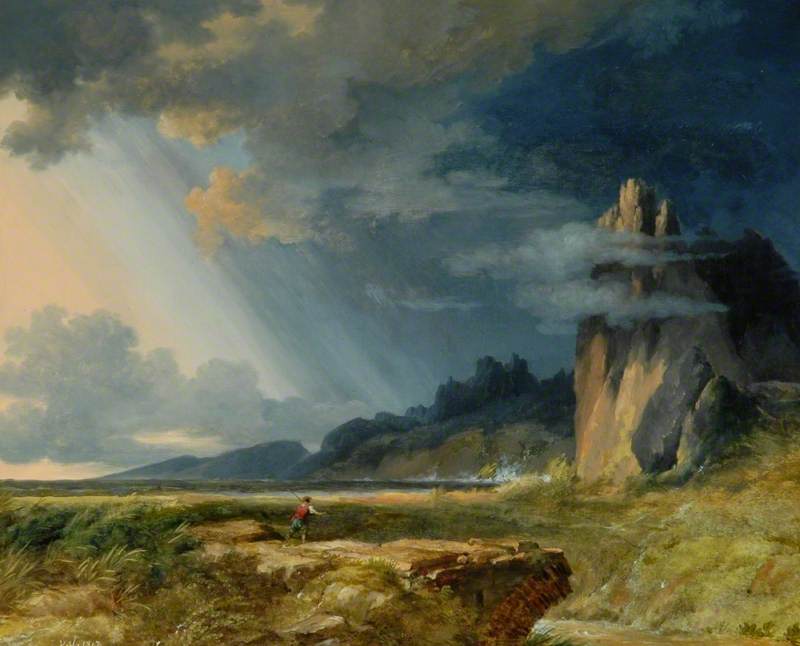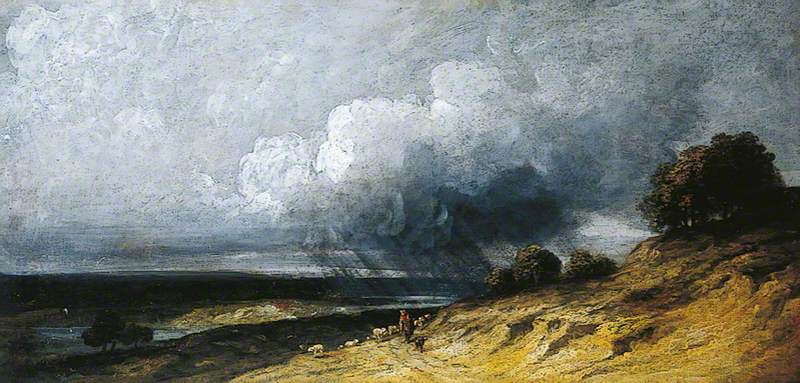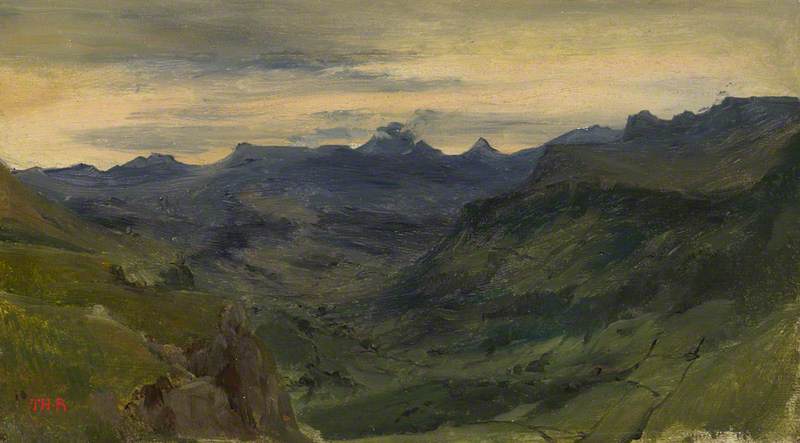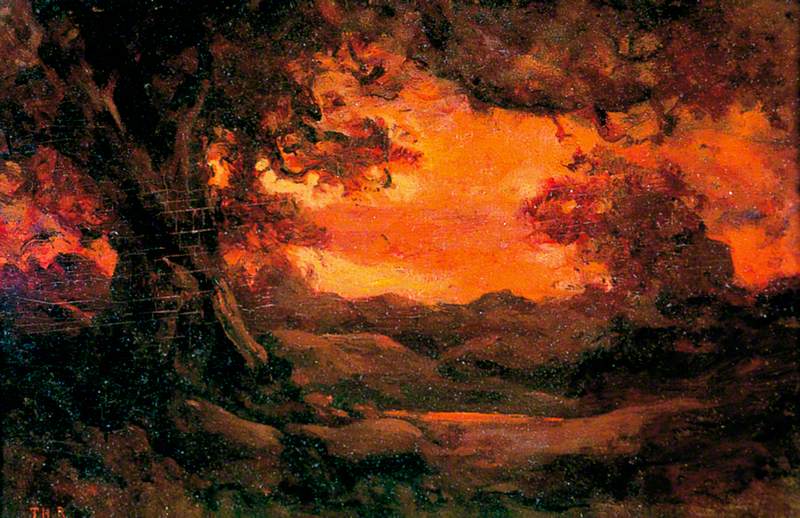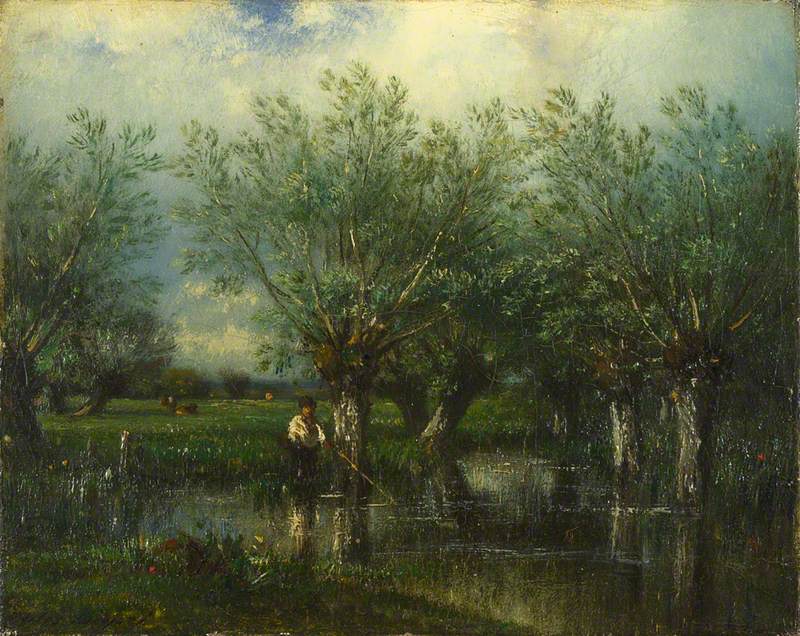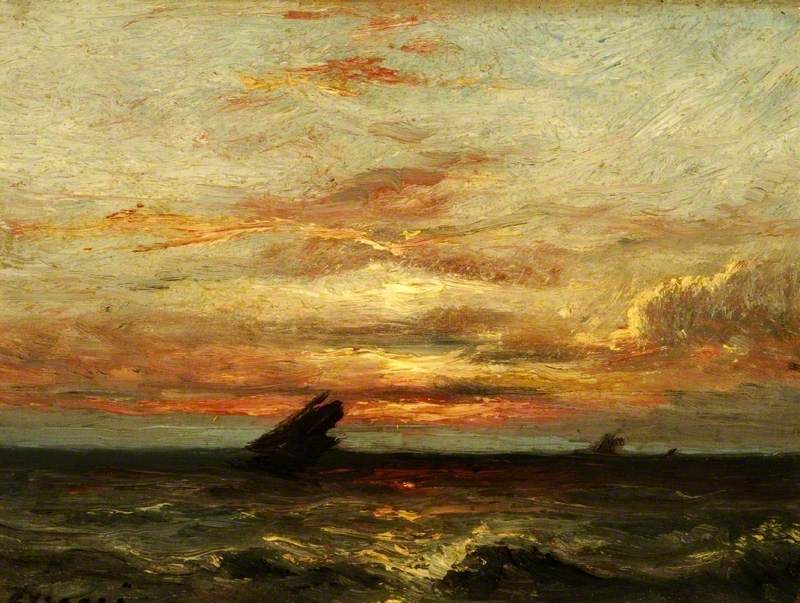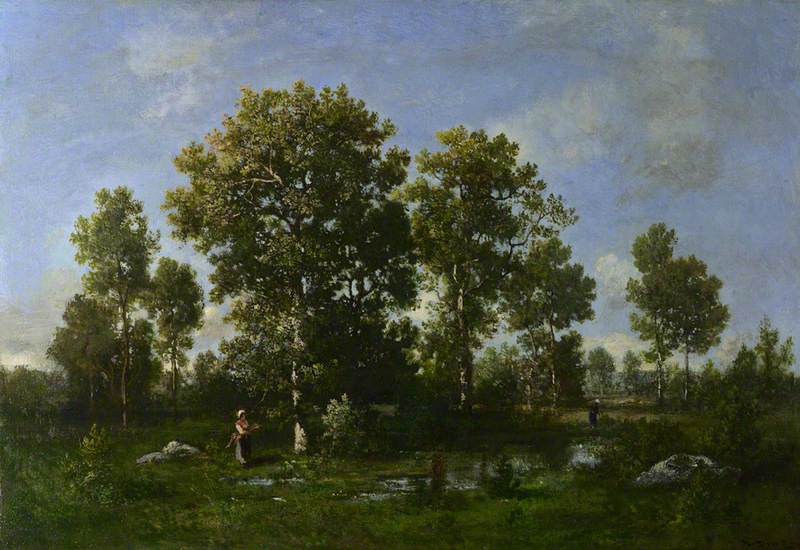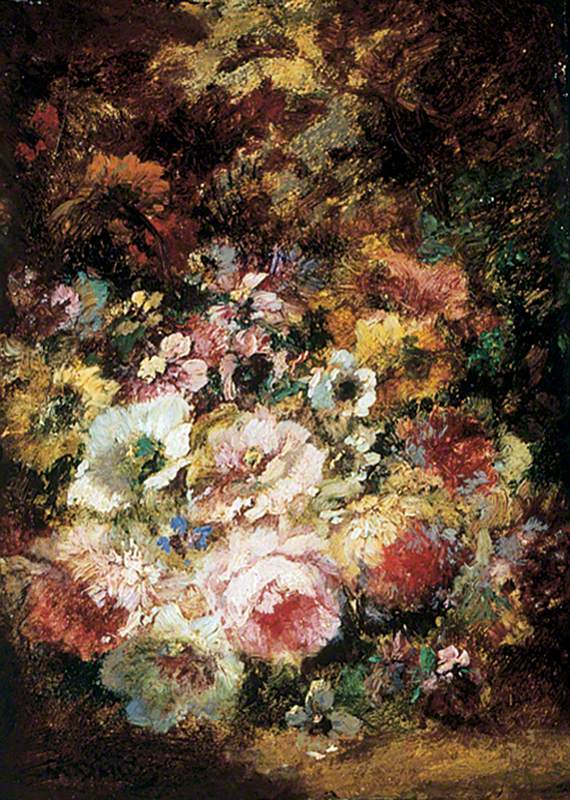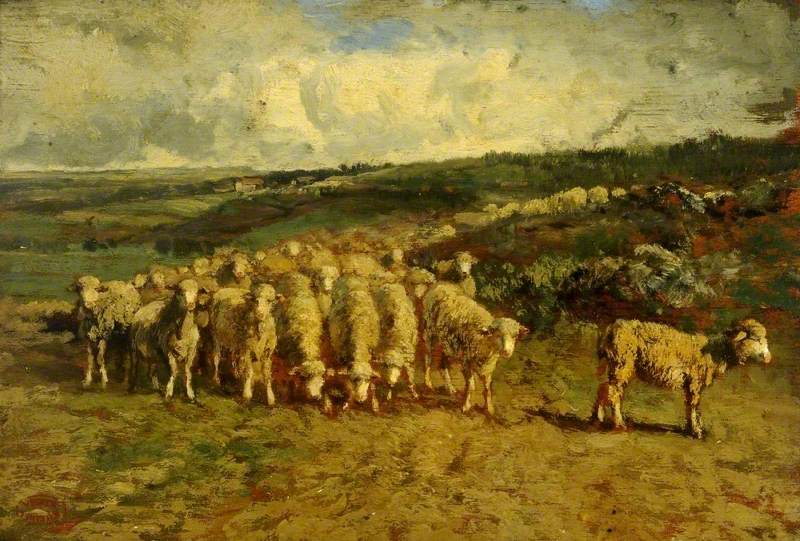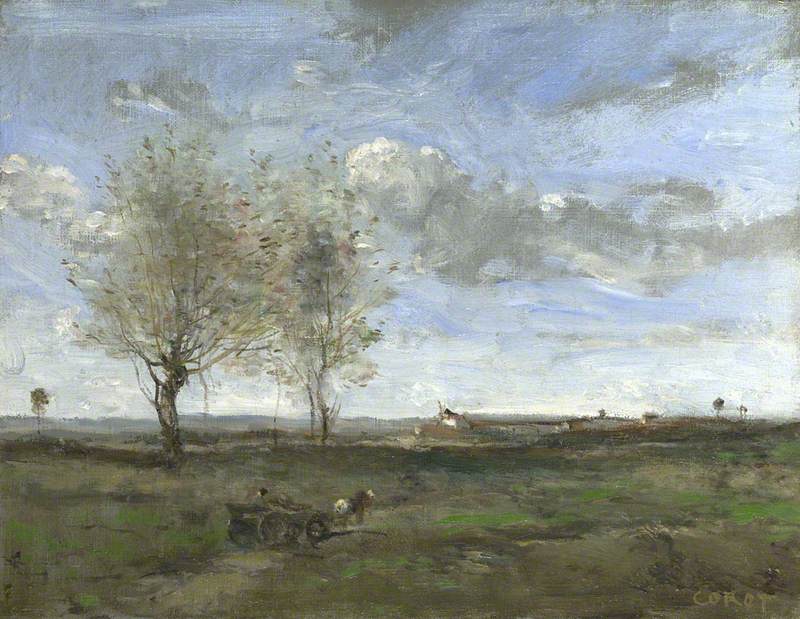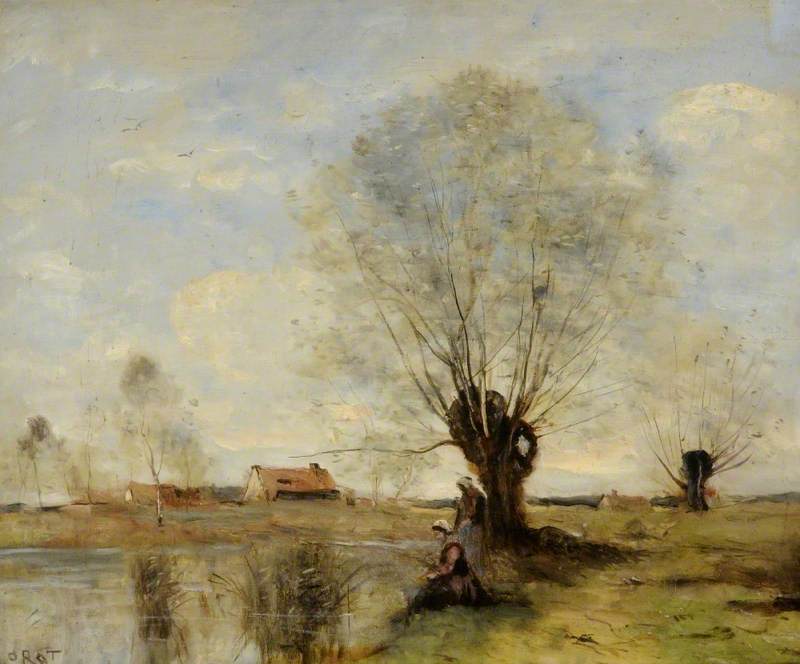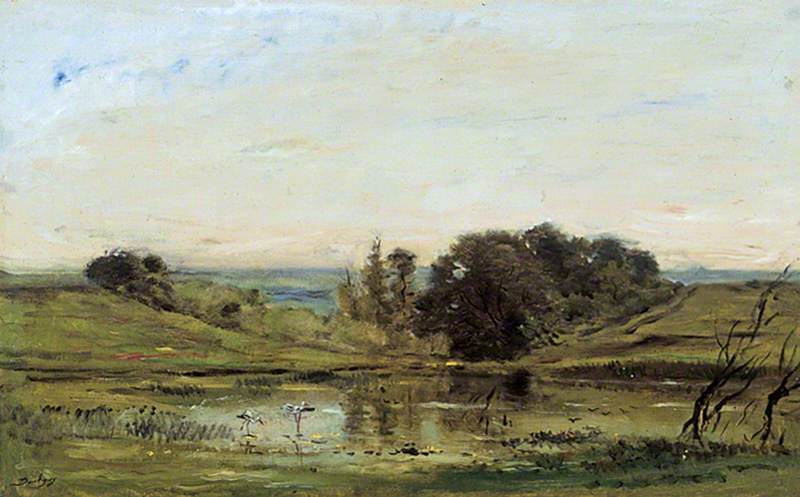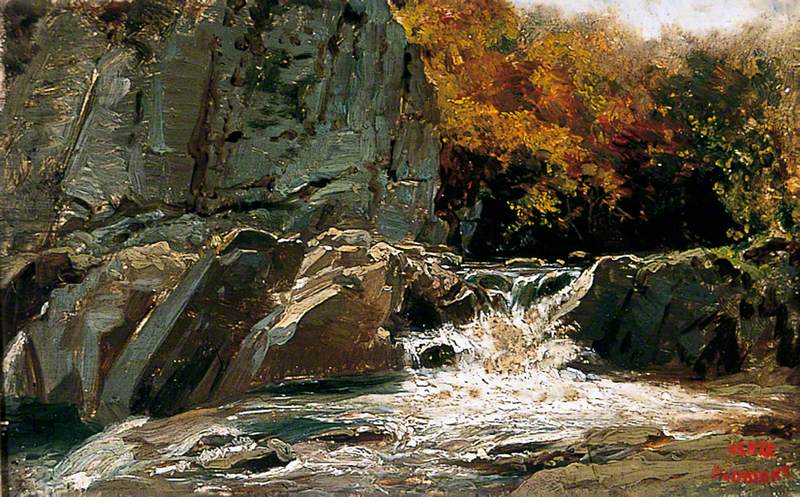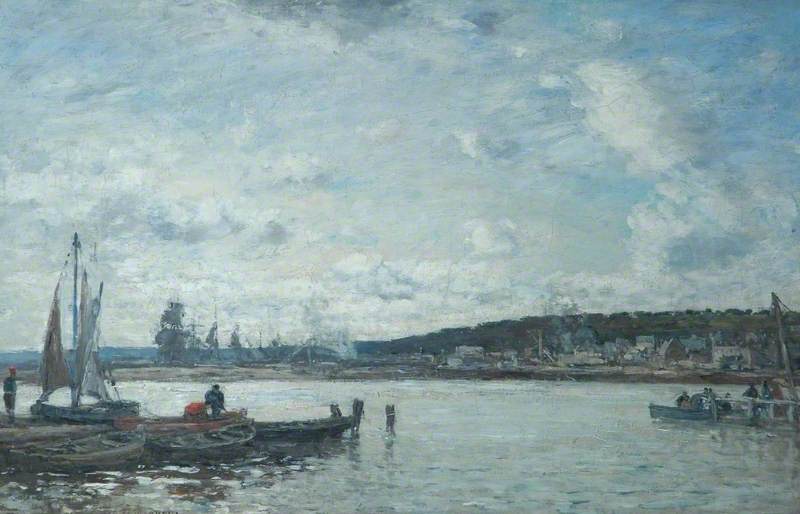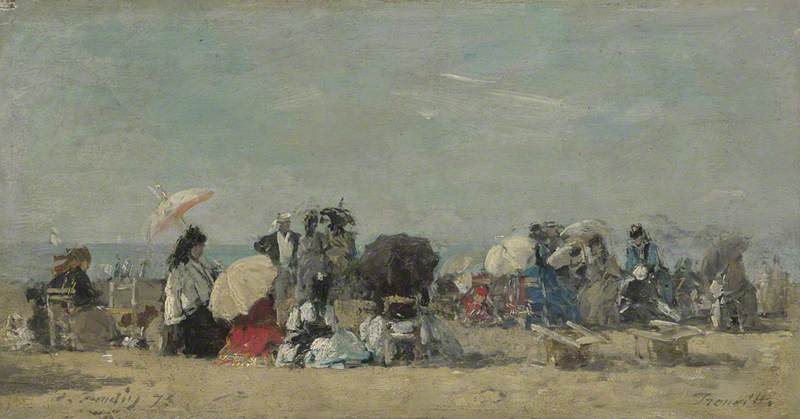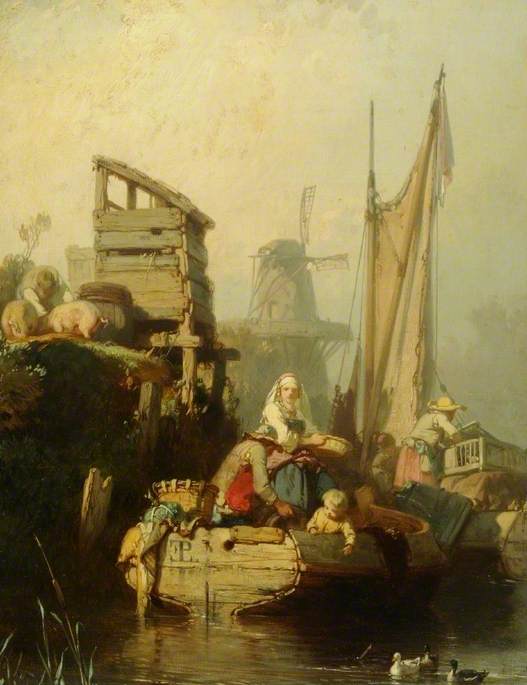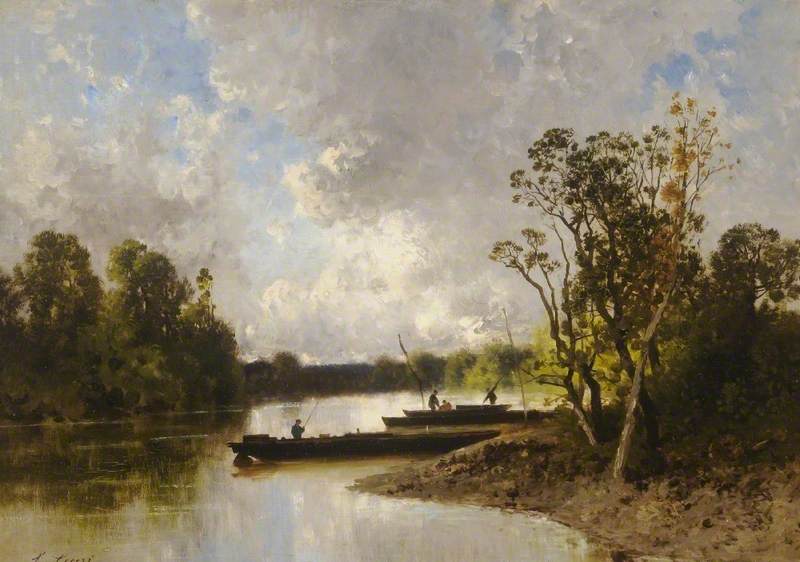The painters of Light and Soul drew inspiration from ancient forests and valleys, contemporary life in the landscape and the shifting light over rivers and seas. The exhibition brings together 17 exceptional artists including Pierre-Henri de Valenciennes, Camille Corot, Rosa Bonheur and Eugène Boudin. All were pioneers who experimented with subject matter, style and technique and whose influence shaped the work of generations to follow.
-
The exhibition is the culmination of a research project into the French drawings and paintings at the Cooper Gallery, funded by the Headley Fellowship through Art Fund. The project focused on the 19th century landscape artists, including those who worked in the Forest of Fontainebleau and along the coastal areas of Normandy. The research also revealed some of the wonderful examples held in other collections and we are delighted to welcome remarkable paintings on loan from Sheffield Museums, York Museums Trust, Leeds Museums and Galleries, The Bowes Museum and The National Gallery, London, displayed alongside the treasures from the Cooper Gallery collection.
Light and Soul
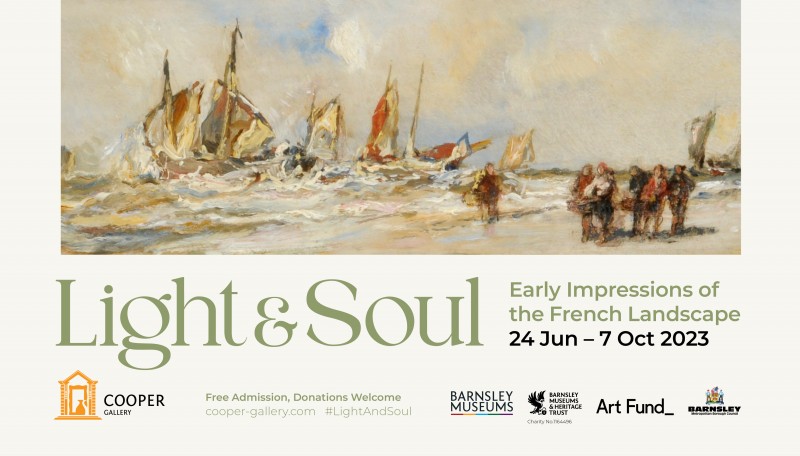 Image credit: The Cooper Gallery
Image credit: The Cooper Gallery
-
Narcisse-Virgile Diaz de la Peña
Bas Breau, par le carrefour de Clair-Bois en la forêt de Fontainebleau, France 1864To the south-east of Paris lies the vast Forest of Fontainebleau, a landscape of dense woodland, imposing boulders, great plateaus and a sandy plain. Between the 1820s and the 1870s painters from Corot and Rousseau to Monet and
Renoir drew inspiration from these varied elements. The forest was a haven for observing nature and its many different atmospheres. The village of Barbizon on the north-west edge of the forest became a gathering place for artists who were later known as the ‘Barbizon School’. This group included several artists in the exhibition such as Rousseau, Diaz, Millet,Troyon and Jules and Léon-Victor Dupré.
Listen to an audio description https://on.soundcloud.com/B49HN
Narcisse Virgile Diaz de la Peña (1807–1876)
Oil on panel
H 30.5 x W 40.5 cm
The Cooper Gallery
-
Pierre Henri de Valenciennes
Landscape, Storm 1817Valenciennes spent most of his career in Italy, studying the golden light and architectural ruins of the Roman countryside. The historical landscapes he sent back to France for the Salon exhibition were very well received.
Valenciennes later became a Professor at the École des Beaux-Arts in Paris and wrote an influential book, Élémens de perspective pratique. The book was a guide for young artists on the use of perspective and the benefits of studying and sketching directly from nature. These two paintings show the artist’s classical style and his focus
on the effects of light and weather.
Pierre Henri de Valenciennes (1750–1819)
Oil on canvas
H 33.7 x W 41.9 cm
The Bowes Museum
-
Landscape, Moonlight 1817
Pierre Henri de Valenciennes (1750–1819)
Oil on canvas
H 33.1 x W 41.2 cm
The Bowes Museum
-
Georges Michel
Storm near Montmartre, Paris, FranceMichel believed there was no need to look further than Paris and its surrounding countryside to be inspired by nature. He followed the tradition of creating studies in the open air but rejected historical landscape themes. Michel worked at the Louvre for a time, restoring 17th century Dutch and Flemish paintings. This inspired him and influenced his style as is shown in his use of light and shade and powerful portrayals of open skies and expansive fields. The oil paintings and coloured sketches in the exhibition show two of Michel’s favourite places - Montmartre and Saint-Denis.
Georges Michel (1763–1843)
Oil on canvas
H 68.6 x W 138.5 cm
Leeds Museums and Galleries
-
The Plain of St Denis 1820–1829
Georges Michel (1763–1843)
Oil on paper on canvas
H 32.4 x W 45.1 cm
York Museums Trust
-
À Carrière St Denis 1836
Georges Michel (1763-1843)
Black chalk and watercolour over pencil on paper
H 15 x W 20.3cm
Listen to an audio description https://on.soundcloud.com/5rypk
The Cooper Gallery
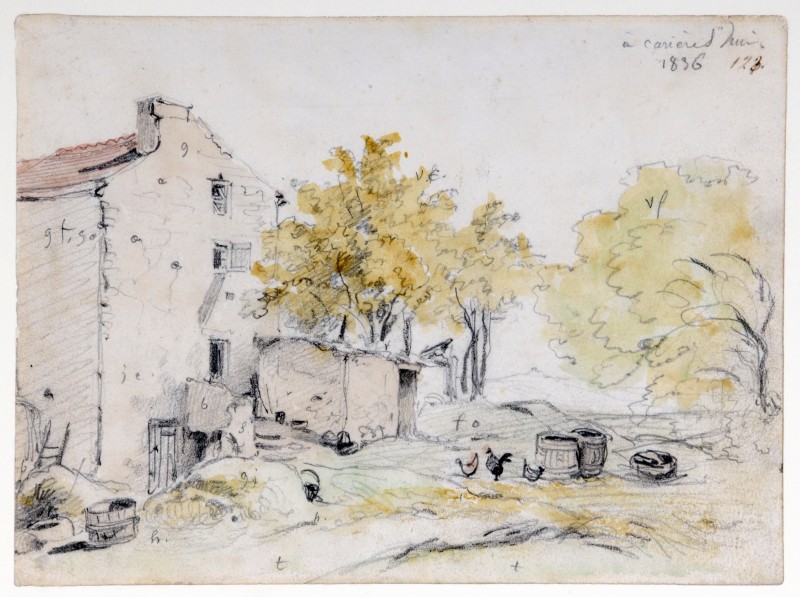 Image credit: The Cooper Gallery
Image credit: The Cooper Gallery
-
Windmills
Georges Michel (1763-1843)
Watercolour and pencil
H 17.8 x H 24.7cm
listen to an audio description https://on.soundcloud.com/ZtMsh
The Cooper Gallery
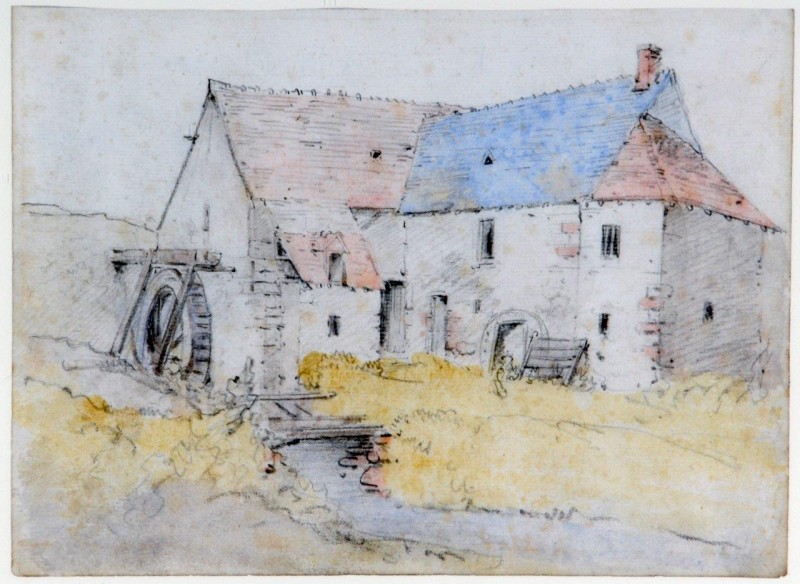 Image credit: The Cooper Gallery
Image credit: The Cooper Gallery
-
Jean-Baptiste-Camille Corot
Corot’s work evolved from a traditional, classical style to innovative experiments. He believed strongly in painting and sketching in the open air and immersed himself in nature throughout his long career. Corot spent three years in Italy in the 1820s but also worked around Paris and Normandy and was one of the first artists to sketch in the Forest of Fontainebleau. Later, he moved away from historical scenes and explored how to create an impression or effect of a landscape. The exhibition features drawings and paintings from different periods which show his varied use of media and techniques.
De Saint Jean et Paul, 1827
(Church of St John and
St Paul, Rome)
Pencil on white paper
audio description https://on.soundcloud.com/kUmx7
The Cooper Gallery
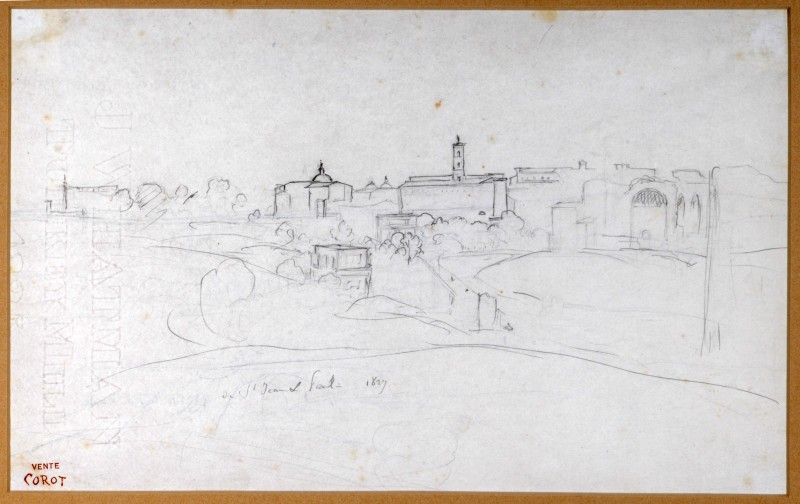 Image credit: The Cooper Gallery
Image credit: The Cooper Gallery
-
Landscape with Trees, 1852
Jean-Baptiste-Camille Corot
Pencil, black chalk and grey wash on thin cream paper
H 23.8 x W 30.2cm
Listen to an audio description https://on.soundcloud.com/NgG5h
The Cooper Gallery
 Image credit: The Cooper Gallery
Image credit: The Cooper Gallery
-
Un Village à Flanc de Coteau, 1852 (A Village on a Hillside)
Jean-Baptiste-Camille Corot
pencil on white paper
H 23.8 x W 30.2cm
Listen to an audio description https://on.soundcloud.com/NLUms
The Cooper Gallery
 Image credit: The Cooper Gallery
Image credit: The Cooper Gallery
-
Figure dans une gorge boisée, c.1870
(Figure in a wooded gorge)
Jean-Baptiste-Camille Corot
Charcoal and brown ink on beige paper
H 43 x W 26.5cm
Listen to an audio description https://on.soundcloud.com/M5NXb
The Cooper Gallery
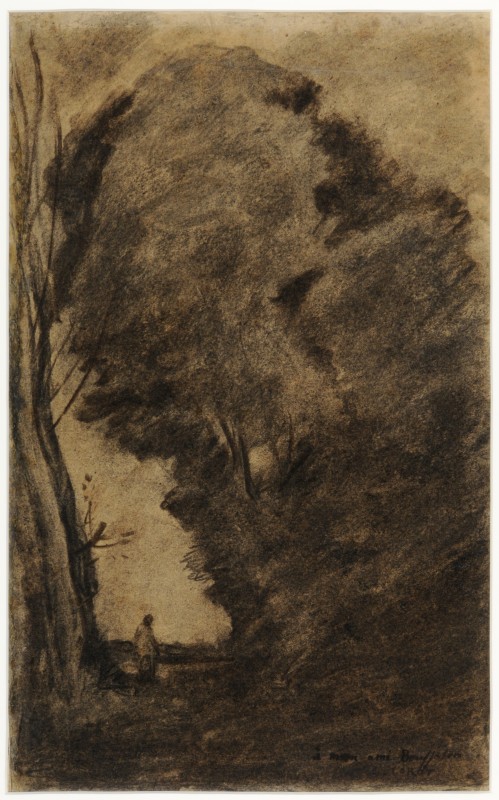 Image credit: The Cooper Gallery
Image credit: The Cooper Gallery
-
The Valley of Saint-Vincent 1830
Théodore Rousseau (1812–1867)
Oil on paper laid on canvas
H 18.2 x W 32.4 cm
The National Gallery, London
-
A Rocky Landscape about 1836-40
Théodore Rousseau (1812–1867)
Oil on millboard
H 27.9 x W 43.5 cm
The National Gallery, London
-
Landscape with Red Sunset c.1850–c.1855
Théodore Rousseau (1812–1867)
Oil on wood
H 30.5 x W 45.8 cm
York Museums Trust
-
Trees and Fields
Theodore Rousseau (1812-1867)
Crayon/chalk on paper
H 15.7 x H 23.5cm
Listen to an audio description https://on.soundcloud.com/gp7yk
The Cooper Gallery
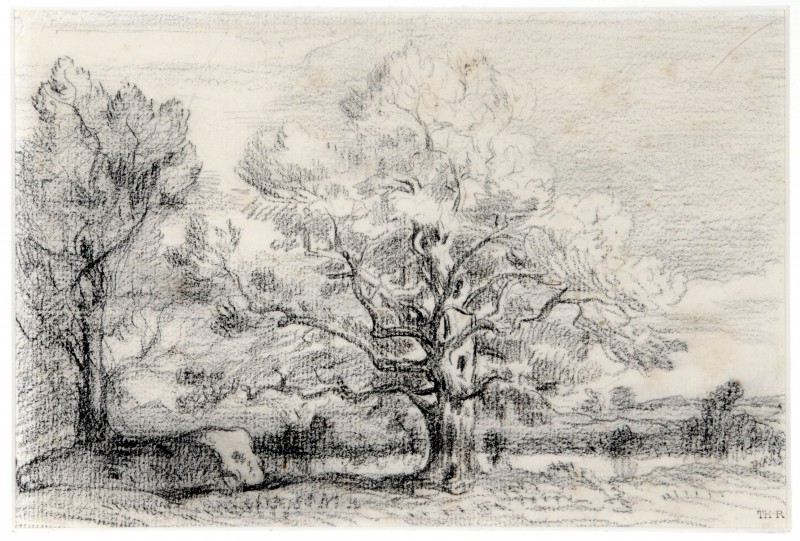 Image credit: The Cooper Gallery
Image credit: The Cooper Gallery
-
Jules Dupré (1811–1889)
Willows, with a Man Fishing probably before 1867Dupré trained as a decorator of porcelain which shows in the fine detail and vivid colours of his work. He began painting landscapes as a teenager and was inspired by 17th century Dutch artists and English contemporaries such as John Constable. He explored many regions of France with fellow artists and became close friends with Théodore Rousseau. Dupré sometimes painted in the Forest of Fontainebleau but preferred L’Isle-Adam on the River Oise,
north of Paris.
Jules Dupré (1811–1889)
Oil on canvas
H 21.7 x W 27.1 cm
The National Gallery, London
-
Coucher du soleil 1879–1889
Jules Dupré (1811–1889)
Oil on canvas
H 15.6 x W 20.9 cm
Museums Sheffield
-
Landscape with Trees
Jules Dupre (1811-1889)
Chalk? on paper
H 58 x H 84.7cm
Listen to an audio description https://on.soundcloud.com/oKMjT
The Cooper Gallery
 Image credit: The Cooper Gallery
Image credit: The Cooper Gallery
-
In the Landes, France c.1841
Théodore Rousseau (1812–1867) and Jules Dupré (1811–1889)
Oil on canvas
H 33 x W 51.1 cm
Leeds Museums and Galleries
-
Pierre-Etienne Théodore Rousseau
The Forest of Fontainebleau
Pierre-Etienne Théodore Rousseau
Pencil/black chalk heightened with white chalk on paper
H 28 x W 45.2cm
Rousseau was considered by many to be the leader of the group of artists who gathered at Barbizon. His extended visits to the Forest of Fontainebleau began in 1833 and he would set off on great expeditions to discover new views, rocks and vegetation. He was often joined on these adventures by other artists. Rousseau was particularly appalled by the changes being made to the forest in thename of tourism and led the petition to Emperor Napoleon III to protect specific areas.
Listen to an audio description https://on.soundcloud.com/4Rfeg
The Cooper Gallery
 Image credit: The Cooper Gallery
Image credit: The Cooper Gallery
-
Chemin â travers les rochers
Theodore Rousseau (1812-1867)
Chalk on paper
H 23.7 x W 36.5cm
Listen to an audio description https://on.soundcloud.com/KDwXw
The Cooper Gallery
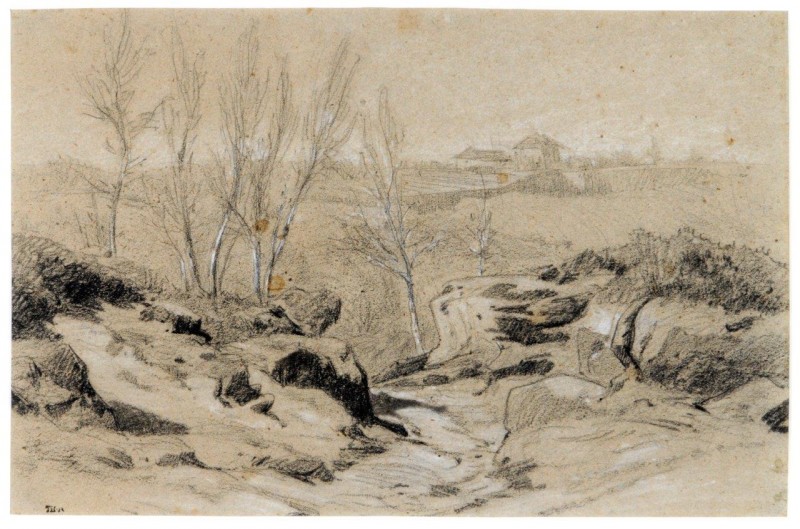 Image credit: The Cooper Gallery
Image credit: The Cooper Gallery
-
Narcisse Virgile Diaz de la Peña
Sunny Days in the Forest probably 1850sDiaz had a talent for portraying a landscape with swift brushstrokes, depth of colour and an understanding of light. He was a versatile artist and his paintings also included flower pieces, genre scenes and religious works.
Diaz had occasional formal lessons but mostly taught himself and learnt from the artists around him. His first meeting with Rousseau inspired Diaz to develop his landscape work and he became the most prolific painter of the Forest of Fontainebleau.
Narcisse Virgile Diaz de la Peña (1807–1876)
Oil on canvas
H 39 x W 56.2 cm
The National Gallery, London
-
Flowers
Narcisse Virgile Diaz de la Peña (1807–1876)
Oil on wood
H 22.8 x W 16.5 cm
Leeds Museums and Galleries
-
Constant Troyon
A Flock of Sheep 1840–1865Troyon worked in landscape in the early stages of his career but went on to greater success as an animal painter. His fondness for sketching outdoors was encouraged by Jules Dupré, Rousseau and Diaz and he worked alongside these artists in the Forest of Fontainebleau. Troyon travelled extensively across France but it was a visit to Holland
which altered his professional path. There, he was inspired by the 17th century Dutch artists who were the masters of creating animal studies and paintings. From that time, he became famous for his skill in depicting animals within a rural landscape.
Listen to an audio description https://on.soundcloud.com/GcwkT
Constant Troyon (1810–1865)
Oil on panel
H 24 x W 36 cm
The Cooper Gallery
-
Rosa Bonheur
Sheep in a LandscapeBonheur’s mother encouraged her to draw an animal to match each letter of the alphabet when she was young, a practice which gave her an early love of creatures. Her father believed in the equality of women and became the director of the only free drawing school for girls in Paris. Their encouragement, combined with Bonheur’s own determination and talent, led to a careeras the leading animal painter of her time. She was the first woman to be awarded the Légion d’Honneur and counted the Empress Eugénie and Queen Victoria amongst her admirers
Rosa Bonheur (1822–1899)
Oil on canvas
H 24.8 x W 35 cm
Museums Sheffield
-
Jean-François Millet
Millet was a central figure in the group of artists at Barbizon but placed a greater emphasis on the people in his landscapes. He grew up in a small village in Normandy and was familiar with daily rural life. From around 1849 when he moved from Paris to Barbizon, Millet chose to portray agricultural
labourers, often the poorest of the poor. The three drawings here by Millet all relate to finished oil paintings or other drawings by the artist. He was constantly producing drawings in different sizes and media and on a variety of papers.
The Shepherdess c.1849
Jean-François Millet
Black and white chalk and grey and brown wash on cream paper
H 16.8 x W 10cm
Listen to an audio description https://on.soundcloud.com/cTJ5S
The Cooper Gallery
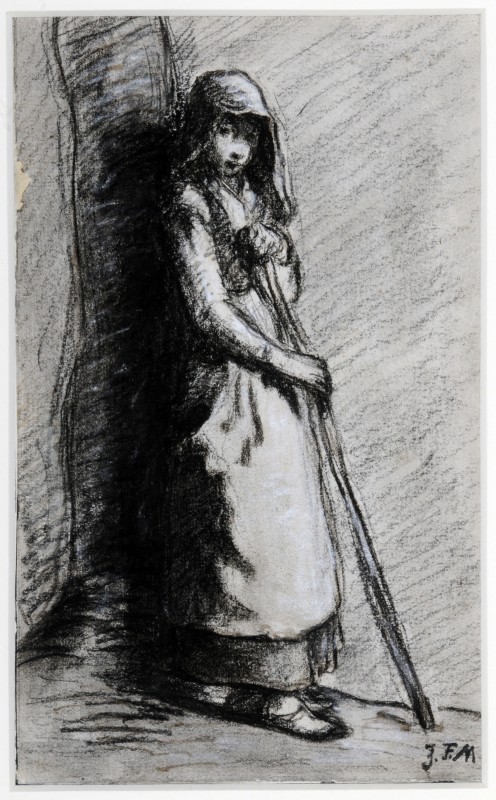 Image credit: The Cooper Gallery
Image credit: The Cooper Gallery
-
The Log Splitter
Jean Francois Millet (1814-1875)
crayon, ink and wash on paper
H 11.5 x W 6.5cm
Listen to an audio description https://on.soundcloud.com/1TGbf
The Cooper Gallery
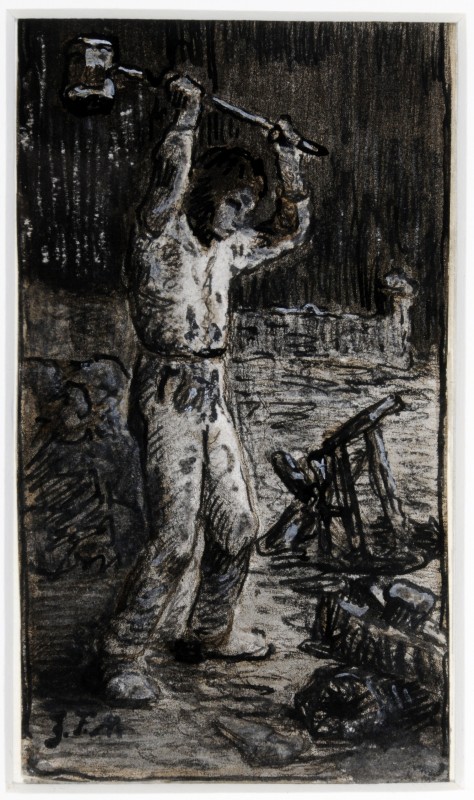 Image credit: The Cooper Gallery
Image credit: The Cooper Gallery
-
Vache a L'Abreuvoir
Jean Francois Millet (1814-1875)
chalk/charcoal on paper
H 11.3 x W 18cm
Listen to an audio description https://on.soundcloud.com/A7hyq
The Cooper Gallery
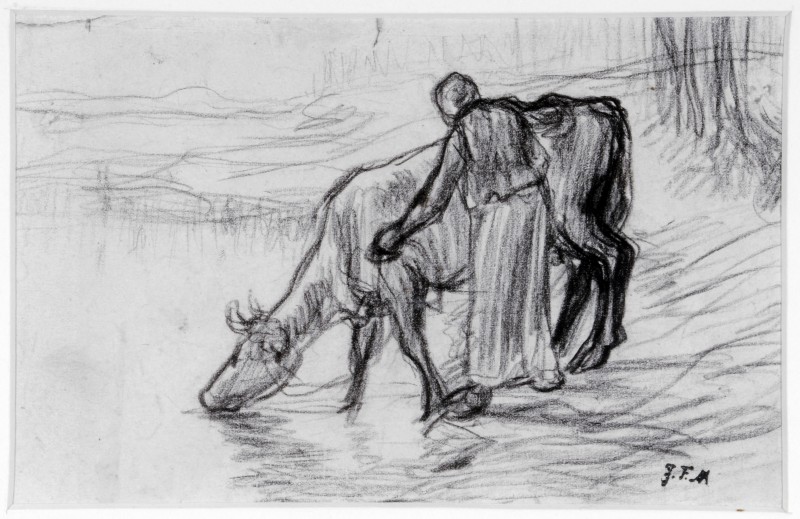 Image credit: The Cooper Gallery
Image credit: The Cooper Gallery
-
Jean-Baptiste-Camille Corot
A Wagon in the Plains of Artois 1871The paintings in the exhibition by Corot and Daubigny show how they captured atmosphere through their interpretation of light, as well as their handling of colours, tones and brushstrokes. They were close
friends and both influenced the next generation of artists who were absorbed by the question of how to create an ‘impression’ of a landscape. ‘Le père Corot’ (father Corot) was affectionately named because of his generous nature and his instincts to look after others. Many young hopefuls would seek him out for advice or help and he was
happy to pass on his philosophy and vast practical experience.
Jean-Baptiste-Camille Corot (1796–1875)
Oil on canvas
H 27.3 x W 35.2 cm
The National Gallery, London
-
Women Fishing 1860–1875
Jean-Baptiste-Camille Corot (1796–1875) (style of)
Oil on canvas
H 37.5 x W 45 cm
The Cooper Gallery
-
Charles-François Daubigny
SolitudeDaubigny’s early career was shaped by academic teachings, but he had many original ideas and was keen to experiment. Encouraged by Corot, he enthusiastically applied himself to painting outdoors and
worked in the Forest of Fontainebleau with Rousseau and Dupré. Daubigny was influenced by these friends but also
responded independently to the landscape, trying out new colours and different tools and brushes. One of his most pioneering moves was to launch ‘Le Botin’, a specially adapted boat which was in effect a floating studio. In
an inspired step, Daubigny made it possible to see nature from a different angle.
Charles-François Daubigny (1817–1878)
Oil on canvas
H 51.4 x W 81.9 cm
Leeds Museums and Galleries
-
The Waterfall c.1870–c.1875
Charles-François Daubigny (1817–1878)
Oil on wood
H 17.8 x W 28.6 cm
York Museums Trust
-
Eugène Louis Gabriel Isabey
The Entrance into Port 1860–1870Isabey’s career was long and illustrious and he was widely regarded as the best marine painter of his time. He excelled in coastal views and painted both dramatic, stormy seas and lighter, more serene views. The studio he
ran in Paris was very popular and he counted Boudin and Jongkind amongst his pupils. Isabey was a favourite of Samuel Joshua Cooper’s. The group of eleven paintings by the artist in the Cooper Gallery collection includes oil paintings and watercolours and a number of historical genre scenes which Isabey also liked to create
Listen to an audio description https://on.soundcloud.com/kj73r
Eugène Isabey (1803–1886)
Oil on canvas
H 50 x W 75 cm
The Cooper Gallery
-
Boats Leaving Shore 1860–1870
Listen to an audio description https://on.soundcloud.com/otd53
Eugène Isabey (1803–1886)
Oil on panel
H 11.5 x W 54 cm
The Cooper Gallery
-
Johan Barthold Jongkind
Coast Scene with Windmills 1873Jongkind was Dutch by birth and in his early artistic training but spent most of his working life in France. As a young man he met Isabey in The Hague and the prominent French artist encouraged Jongkind to move to Paris,
where he joined Isabey’s studio. Jongkind had an exceptional talent for illuminating a landscape and painted along the Seine, the Normandy coast and later in southern and eastern France. His memories of Holland continued to inspire his work though, as seen here in this winter scene of skaters.
Listen to an audio description https://on.soundcloud.com/XC3pj
Johan Barthold Jongkind (1819–1891)
Oil on canvas
H 23 x W 30.5 cm
The Cooper Gallery
-
Eugène Louis Boudin
The Ferry at Deauville, FranceBoudin was a self-taught and pioneering artist, well-known for mentoring his young friend Claude Monet. Boudin was born in Honfleur into a family of modest means and spent many years developing his paintings of shipping and harbours. In the summer of 1862, he painted his first beach scenes on the advice and encouragement of Isabey.
These fresh and inspired observations of the elegant people visiting Trouville and Deauville brought him great success. Whether studying a port or a beach, Boudin’s focus was on the changing light and weather and how they
shaped movement and colour.
Eugène Louis Boudin (1824–1898)
Oil on canvas
H 30.5 x W 47 cm
The Bowes Museum
-
Beach Scene, Trouville 1873
Eugène Louis Boudin (1824–1898)
Oil on wood
H 15.5 x W 29.9 cm
The National Gallery, London
-
Eugène Modeste Edmond Lepoittevin
A River LandscapeLe Poittevin was a versatile artist, skilled in academic, classical and romantic painting. He carved out a successful career with his historical and marine scenes. He also had a passion for representing daily working life,
particularly in the fishing villages and on the beaches of Normandy. Whilst travelling in Europe he developed a deep affinity with the work of the Dutch landscape painters of the 17th century. The painting on display is an excellent example of this, with its everyday subject matter, muted colours and contrasting light.
Listen to an audio description https://on.soundcloud.com/U8w9X
Eugène Modeste Edmond Lepoittevin (1806–1870)
Oil on canvas
H 39 x W 32 cm
The Cooper Gallery
-
Eugène Cicéri
A Bavarian Lake with Fishing Boats 1877In contrast to Le Poittevin, Ciceri was devoted to landscapes throughout his career. A serene and beautifully painted picture, this landscape shows the artist’s three favourite elements - water, sky and trees. Nephew to Eugène Isabey, Ciceri studied alongside Jongkind in Isabey’s studio in Paris and travelled with them both to Normandy. His uncle taught him how to sketch outdoors and he absorbed Isabey’s fondness for the picturesque. He also developed his own style with calmer brushstrokes, a more tranquil feel and fine detail.
Listen to an audio description https://on.soundcloud.com/hnhrm
Eugène Cicéri (1813–1890)
Oil on panel
H 31.5 x W 46 cm
The Cooper Gallery
-
Joséphine Bowes
Avenue of Poplars c.1866–1869Bowes was a talented artist as well as a collector. Her training in Paris was with Karl-Josef Kuwasseg, a well-known landscape painter. She enjoyed creating oil studies directly from nature and took sketching trips into the Forest of Fontainebleau. Travelling with her husband between France and England gave plenty of opportunity for creating coastal studies. Bowes had a fear of the sea and would only cross the Channel when the waves were calm. This often meant waiting for days or even weeks on the coast. She used this time to paint many scenes around Calais
and Boulogne.
Joséphine Bowes (1825–1874)
Oil on canvas
H 86.9 x W 63.1 cm
The Bowes Museum
-
Study of Poplars c.1860–1874
Joséphine Bowes (1825–1874)
Oil on canvas
H 30.6 x W 44.4 cm
The Bowes Museum
-
Landscape with Cows and Figures 1864
Léon Victor Dupré (1816–1879)
Oil on canvas
H 32.5 x W 46.2 cm
The Bowes Museum
Explore artists in this Curation
View all 16-
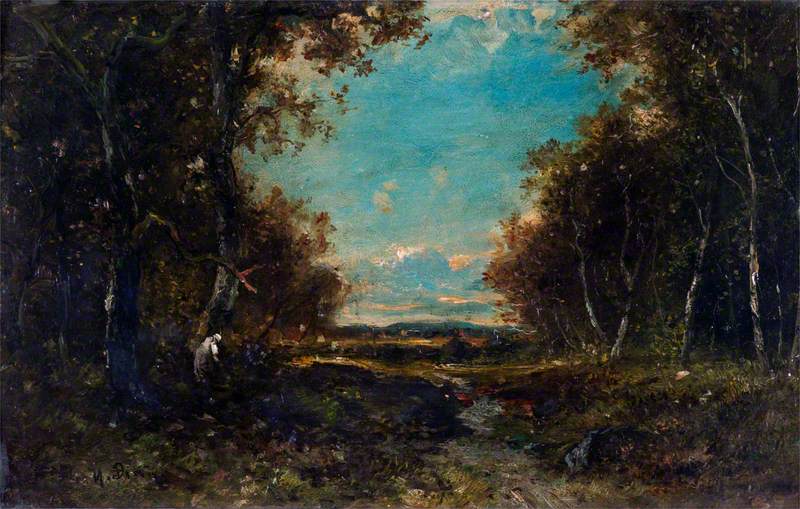 Narcisse Virgile Diaz de la Peña (1807–1876)
Narcisse Virgile Diaz de la Peña (1807–1876) -
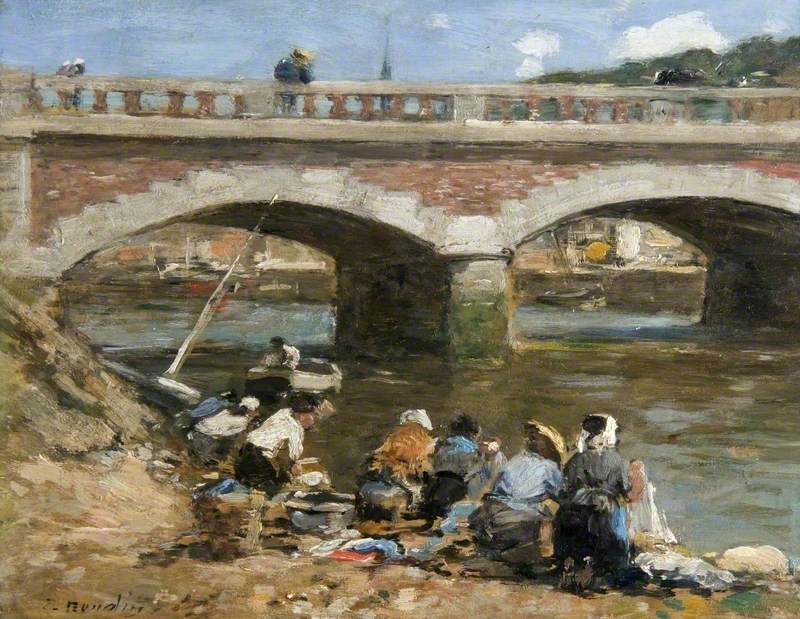 Eugène Louis Boudin (1824–1898)
Eugène Louis Boudin (1824–1898) -
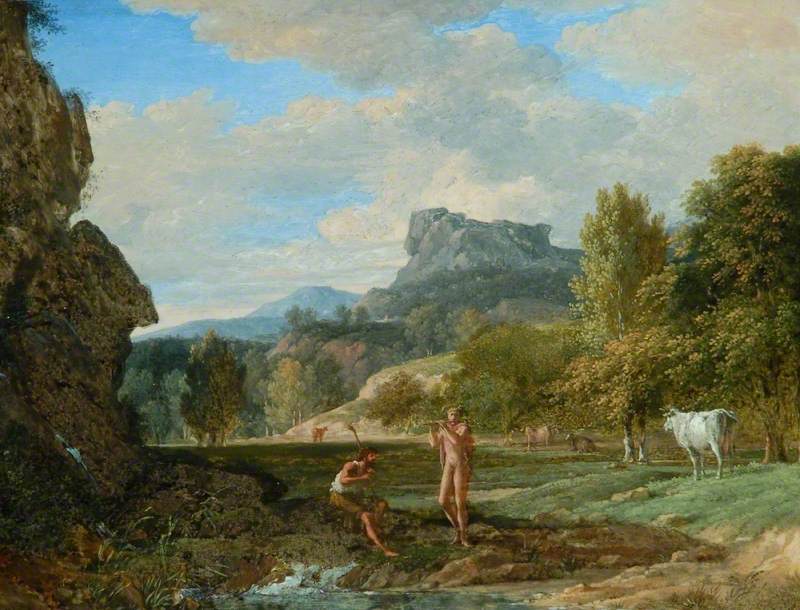 Pierre Henri de Valenciennes (1750–1819)
Pierre Henri de Valenciennes (1750–1819) -
 Johan Barthold Jongkind (1819–1891)
Johan Barthold Jongkind (1819–1891) -
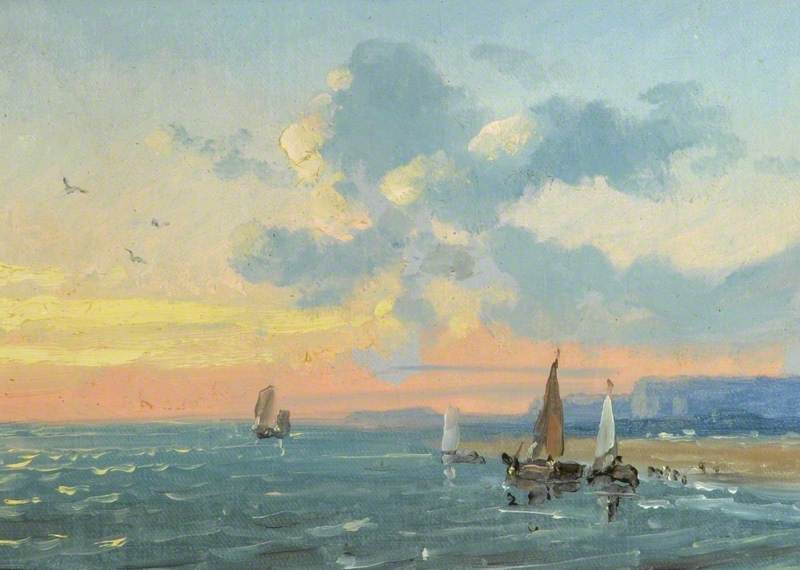 Joséphine Bowes (1825–1874)
Joséphine Bowes (1825–1874) -
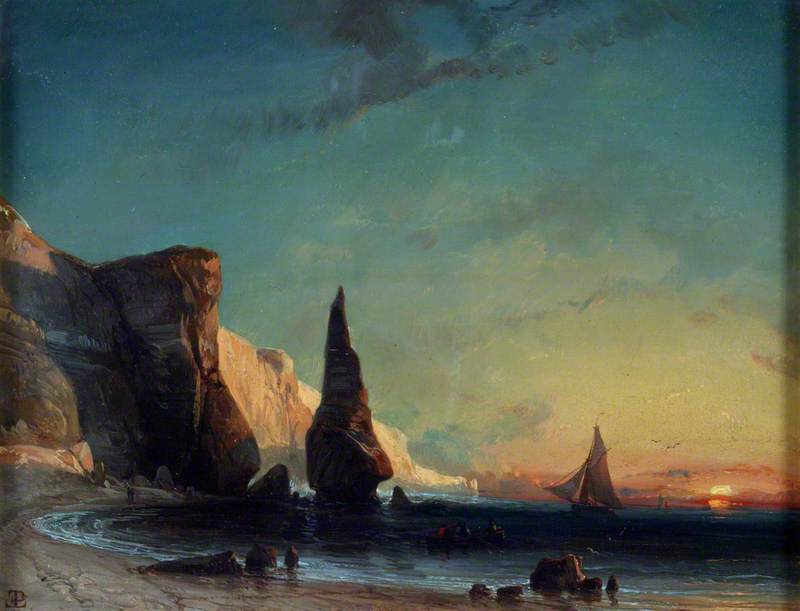 Eugène Modeste Edmond Lepoittevin (1806–1870)
Eugène Modeste Edmond Lepoittevin (1806–1870) -
 Rosa Bonheur (1822–1899)
Rosa Bonheur (1822–1899) -
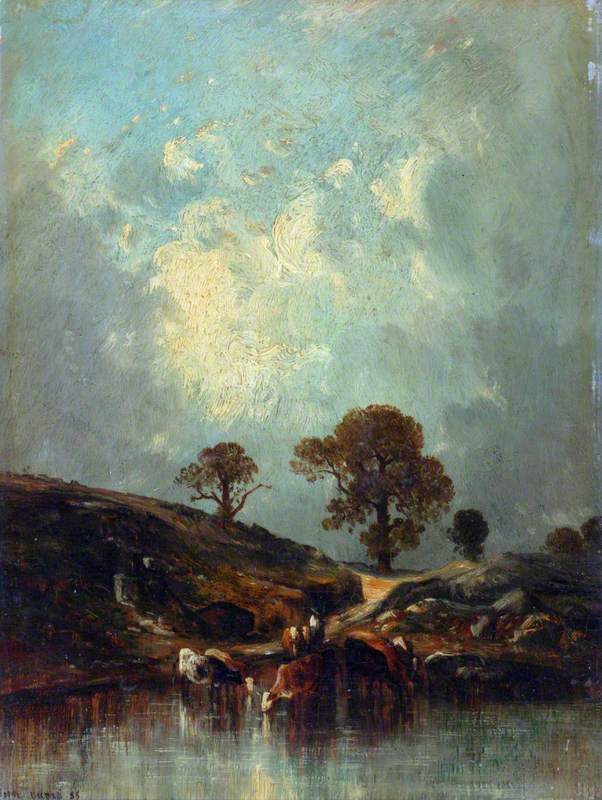 Léon Victor Dupré (1816–1879)
Léon Victor Dupré (1816–1879) -
 Eugène Isabey (1803–1886)
Eugène Isabey (1803–1886) -
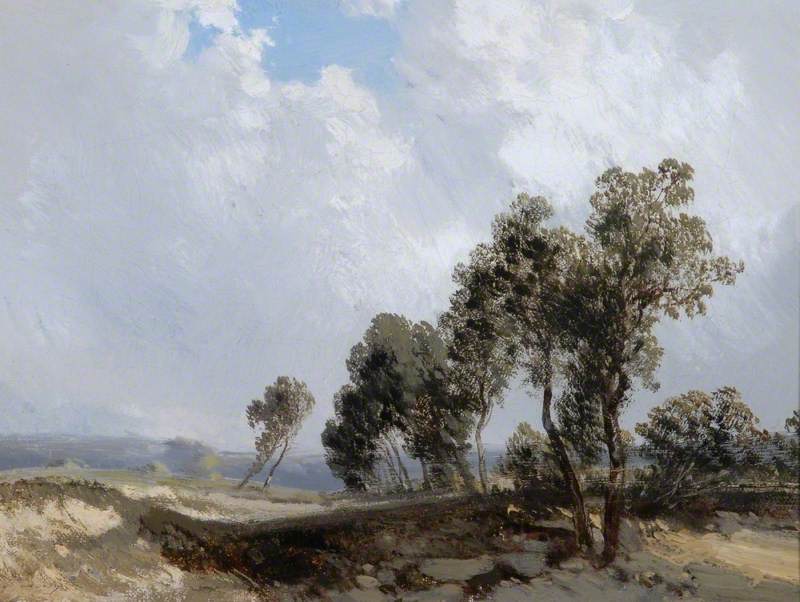 Eugène Cicéri (1813–1890)
Eugène Cicéri (1813–1890) - View all 16

